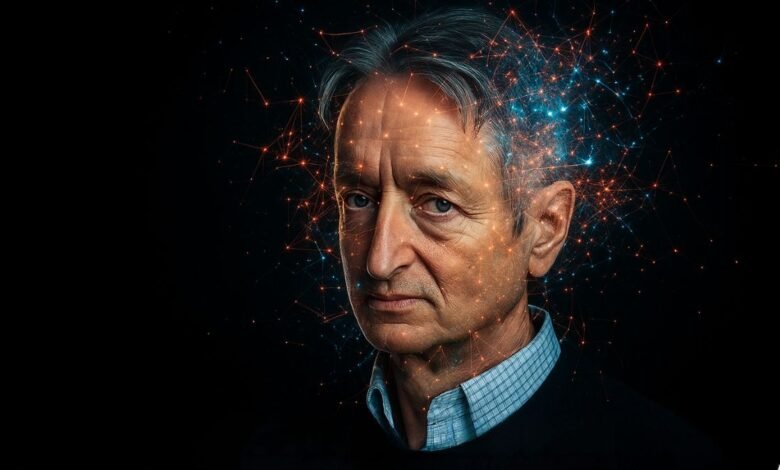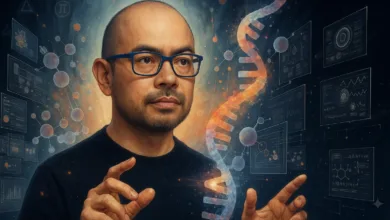Meat Geoffrey Hinton “The Architect of Deep Learning”

▼ Summary
– Geoffrey Hinton is known as the “Godfather of Deep Learning” for his foundational work that enabled modern AI technologies like generative AI and image recognition.
– He co-authored a seminal paper in the 1980s on backpropagation, a key algorithm for training neural networks that remains central to deep learning today.
– Hinton’s guidance led to the 2012 breakthrough with AlexNet, which dramatically improved image recognition and sparked the commercial AI boom.
– He received top honors including the 2018 Turing Award and the 2024 Nobel Prize in Physics for his contributions to neural networks and machine learning.
– In 2023, he left Google to warn about AI’s existential risks, such as job displacement and loss of human control, becoming a prominent ethical voice in the field.
When the history of 21st-century technology is written, one name will be fundamental to the rise of artificial intelligence: Geoffrey Hinton. Often called the “Godfather of Deep Learning,” his decades of persistent research laid the groundwork for the generative AI, advanced image recognition, and powerful translation tools we use today. His journey from a niche academic pursuit to becoming a Nobel Prize winner, and a prominent cautionary voice, maps the trajectory of AI itself.
Origins and Early Path
Born in London on December 6, 1947, Hinton was seemingly destined for a life of inquiry, descending from a family of noted scientists. His academic path started not with computers, but with the mind, earning a BA in Experimental Psychology from the University of Cambridge in 1970. This foundation in cognitive science proved crucial, leading him to a PhD in Artificial Intelligence from the University of Edinburgh in 1978.
His early work was driven by a foundational question: could the human mind’s complex workings be mirrored in a machine? After posts at Carnegie Mellon University, he moved to the University of Toronto, where he established a dedicated research group for neural networks and machine learning.
Turning Point: Neural Networks and Backpropagation
For many years, neural networks were considered a fringe concept in the wider AI field. Hinton’s work was instrumental in changing that perception. A critical moment arrived in the mid-1980s when he, alongside David Rumelhart and Ronald J. Williams, co-authored a seminal paper. This work explored the use of the backpropagation algorithm for training multi-layer networks, a technique that remains one of the core building blocks of deep learning.
While others moved on, Hinton persisted, investigating ideas like Boltzmann machines, deep belief nets, and distributed representations. These methods all treat learning as a process of adjusting the connections within layered networks of artificial neurons.
A widely celebrated milestone finally arrived in 2012. Two of his students, with his guidance, built the network known as “AlexNet.” It achieved a breakthrough in image-recognition accuracy, decisively winning a major competition. That single result was the catalyst that shifted deep learning from a theoretical curiosity to an industrial and commercial reality.
Recognition and Growing Concerns
Hinton’s foundational contributions have earned him the highest honors in science and computing. In 2018, he was a co-recipient of the ACM A.M. Turing Award (often called the “Nobel of Computing”) with Yoshua Bengio and Yann LeCun, recognizing their shared role in making deep learning a powerful force. This was followed in 2024 by the Nobel Prize in Physics, which he shared with John Hopfield, “for foundational discoveries and inventions that enable machine learning with artificial neural networks.”
Yet, at the peak of his field’s success, Hinton took an unexpected turn. In 2023, he stepped down from his role at Google. He stated he left so he could speak more freely about the profound risks posed by AI. In numerous interviews, the field’s architect has become its most prominent skeptic, warning of dangers ranging from massive job displacement and misinformation to the concentration of power and the ultimate risk of developing systems that could out-pace human control.
Why His Work Matters
At the heart of Hinton’s legacy is the conceptual shift from shallow machine-learning models to the deep, layered networks capable of recognizing and generating incredibly complex patterns. Without these advances, the modern digital world would look very different. We would lack the sophisticated voice recognition in our phones, the automatic image tagging on social media, and the powerful generative AI services that are now reshaping entire industries.
For the world of digital publishing and marketing, his work is not just abstract science; it’s the engine. The content-generation tools and the very nature of the SEO landscape are being redefined by these technologies. As search engines like Google adapt to a flood of AI-generated content, it is the foundational research by figures like Hinton that underpins the entire shift.
Looking Ahead
Hinton now sees a future where the primary question is not “Can we build smarter machines?” but “How do we manage machines that may become smarter than us?” His warnings carry unique weight precisely because they come from the person who arguably did the most to build the field. For professionals in digital consulting and technology, his journey serves as a powerful reminder that technical capability and ethical readiness must advance in tandem.
His career also offers a profound lesson in patience. For decades, neural network research lacked funding and momentum. Hinton’s persistence, his belief in the idea when it was unpopular, is why the payoff eventually emerged. For any agency crafting digital solutions, the lesson is clear: true innovation requires both vision and the rigorous follow-through to see it to fruition.
/* ————————————————— */ /* ALL STYLES ARE NOW SELF-CONTAINED. NO TAILWIND. */ /* ————————————————— */#hinton-timeline-embed { font-family: -apple-system, BlinkMacSystemFont, “Segoe UI”, Roboto, “Helvetica Neue”, Arial, sans-serif; color: #1f2937; width: 100%; max-width: 900px; margin: 0 auto; padding: 48px 16px; box-sizing: border-box; } #hinton-timeline-embed > header { text-align: center !important; margin-bottom: 48px; } #hinton-timeline-embed .header-title { font-size: 2.25rem; line-height: 2.5rem; font-weight: 700; color: #ffffff; } #hinton-timeline-embed .header-subtitle { font-size: 1.25rem; line-height: 1.75rem; color: #f34c3e; margin-top: 0.5rem; }/* — Timeline Structure — */ #hinton-timeline-embed .timeline-container { position: relative; width: 100%; margin: 0 auto; padding: 40px 0; } #hinton-timeline-embed .timeline-trunk { position: absolute; width: 4px; background-color: #dee2e6; top: 0; bottom: 0; left: 50%; margin-left: -2px; } #hinton-timeline-embed .timeline-node { padding: 20px 40px; position: relative; width: 50%; box-sizing: border-box; /* Added for stability */ } #hinton-timeline-embed .timeline-circle { content: ”; position: absolute; width: 25px; height: 25px; background-color: white; border: 4px solid #f34c3e; top: 25px; border-radius: 50%; z-index: 1; box-sizing: border-box; } /* — Left/Right Alignment — */ #hinton-timeline-embed .timeline-left { left: 0; } #hinton-timeline-embed .timeline-left .timeline-circle { right: -14px; /* (25px width / 2) + 2px margin */ left: auto; } #hinton-timeline-embed .timeline-right { left: 50%; } #hinton-timeline-embed .timeline-right .timeline-circle { left: -12px; /* (25px width / 2) */ right: auto; } /* — Content Box Styling — */ #hinton-timeline-embed .timeline-content { padding: 15px 25px; background-color: white; border: 1px solid #e2e8f0; position: relative; border-radius: 8px; box-shadow: 0 4px 6px -1px rgba(0, 0, 0, 0.1), 0 2px 4px -1px rgba(0, 0, 0, 0.06); transition: transform 0.3s ease, box-shadow 0.3s ease; cursor: pointer; } #hinton-timeline-embed .timeline-content:hover { transform: translateY(-3px); box-shadow: 0 10px 15px -3px rgba(0, 0, 0, 0.1), 0 4px 6px -2px rgba(0, 0, 0, 0.05); } #hinton-timeline-embed .timeline-date { font-size: 0.875rem; font-weight: 600; color: #f34c3e; margin-bottom: 5px; } #hinton-timeline-embed .timeline-title { font-size: 1.125rem; font-weight: 700; color: #1f2937; } /* — NEWLY ADDED DESCRIPTION STYLE — */ #hinton-timeline-embed .timeline-description { font-size: 0.9rem; color: #4b5563; /* A slightly lighter gray */ margin-top: 8px; line-height: 1.4; /* Clamp text to 3 lines */ display: -webkit-box; -webkit-line-clamp: 3; -webkit-box-orient: vertical; overflow: hidden; }/* — Mobile Responsive — */ @media screen and (max-width: 768px) { #hinton-timeline-embed .timeline-trunk { left: 31px; } #hinton-timeline-embed .timeline-node { width: 100%; padding-left: 70px; padding-right: 25px; } #hinton-timeline-embed .timeline-left .timeline-circle, #hinton-timeline-embed .timeline-right .timeline-circle { left: 19px; right: auto; } #hinton-timeline-embed .timeline-left { left: 0%; } #hinton-timeline-embed .timeline-right { left: 0%; } }/* — Modal Styling — */ #hinton-timeline-embed .modal-overlay { position: fixed; top: 0; left: 0; right: 0; bottom: 0; background-color: rgba(0, 0, 0, 0.5); display: flex; align-items: center; justify-content: center; z-index: 10000; opacity: 0; visibility: hidden; transition: opacity 0.3s ease, visibility 0.3s ease; } #hinton-timeline-embed .modal-overlay-active { opacity: 1; visibility: visible; } #hinton-timeline-embed .modal-content { background-color: white; padding: 2rem; border-radius: 0.5rem; max-width: 500px; width: 90%; transform: scale(0.95); transition: transform 0.3s ease; box-sizing: border-box; } #hinton-timeline-embed .modal-overlay-active .modal-content { transform: scale(1); } #hinton-timeline-embed .modal-title { font-size: 1.5rem; line-height: 2rem; font-weight: 700; color: #1f2937; margin-bottom: 1rem; } #hinton-timeline-embed .modal-description { color: #374151; margin-bottom: 1.5rem; } #hinton-timeline-embed .modal-close-btn { width: 100%; padding: 0.5rem 1rem; background-color: #f34c3e; color: white; border: none; border-radius: 0.5rem; font-weight: 600; cursor: pointer; transition: opacity 0.2s ease; } #hinton-timeline-embed .modal-close-btn:hover { opacity: 0.9; }Geoffrey Hinton
The Architect’s Journey
Born in London, UK, into a family with a strong scientific lineage, including mathematician George Boole.
Graduates from Cambridge with a psychology degree, shaping his view on modeling the mind.
Earns his PhD from the University of Edinburgh, setting the stage for his lifelong focus on neural networks.
Co-authors a seminal paper on the backpropagation algorithm, a viable way to train deep neural networks.
Moves to the University of Toronto, establishing a world-leading research group in machine learning.
Hinton continues to research neural networks even as the field falls out of favor, facing widespread skepticism.
His students create ‘AlexNet,’ which shatters image recognition records and sparks the modern AI boom.
Google acquires his startup, DNNresearch Inc. He joins Google as a VP and Engineering Fellow.
Shares the ACM A.M. Turing Award, the ‘Nobel of Computing,’ for foundational contributions to deep learning.
Resigns from Google to speak freely about the existential risks of AI, warning of dangers to humanity.
Awarded a share of the Nobel Prize in Physics ‘for foundational discoveries’ that enable neural network machine learning.
